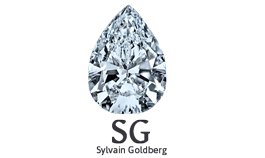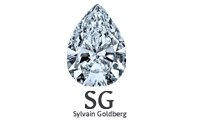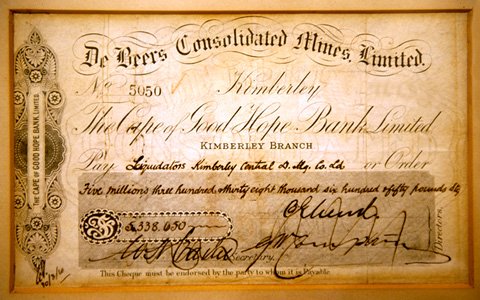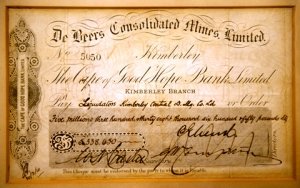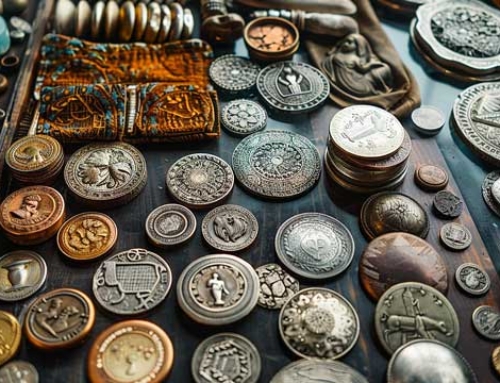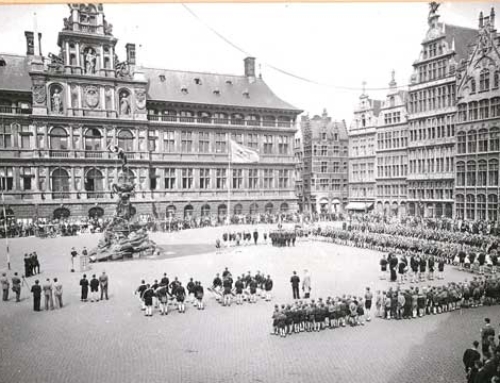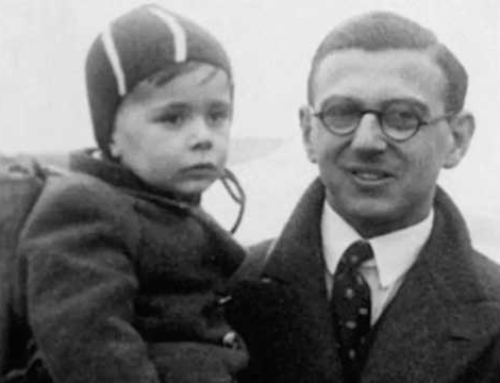Alpha and Omega History of De Beers Company
For decades, De Beers was the preeminent name in diamonds. Thanks to a stockpile of the world’s rough diamond supply, indelible marketing schemes and even negotiations with foreign governments for their diamonds, De Beers — owned by the Oppenheimer family since the 1920’s — was the most important name in one of the world’s most lucrative businesses for almost a century.
This Alpha and Omega history starts in 1866, in South Africa
It all starts out in South Africa in 1866, when Erasmus Jacobs, a 15-year-old farmer’s son, finds Africa’s first authenticated diamond near the Orange River. Erasmus gives the gleaming stones to his sisters, to play with it. Later, his mother gives it to one of her neighbours. This stone is the Eureka Diamond, a 21.25 carat rough diamond. Three years later a herdsman finds the Star of South Africa, an 83.5 carat rough diamond. This triggers the first diamond rush. The herdsman exchanges the stone for 500 sheep, 10 head of cattle and a horse.
Cecil Rhodes and the Barnato Brothers
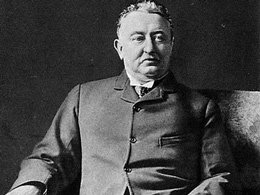 In 1870, at the age of 17, Cecil Rhodes arrives in South Africa. He sells ice to miners in the hot African sun and saves his profit. In 1871 both the De Beers Mine and Kimberley Mine are discovered, within a few months of each other. For nearly a century, the latter is the world’s richest mine. Barney Barnato, 18, a one-time music hall turn, joins his brother in Kimberley in 1873. Barney becomes a diamond millionaire within 10 years of arriving there. ‘Barnato Brothers Dealers in Diamonds and Brokers in Mining Property’ formally opens for business in 1874.
In 1870, at the age of 17, Cecil Rhodes arrives in South Africa. He sells ice to miners in the hot African sun and saves his profit. In 1871 both the De Beers Mine and Kimberley Mine are discovered, within a few months of each other. For nearly a century, the latter is the world’s richest mine. Barney Barnato, 18, a one-time music hall turn, joins his brother in Kimberley in 1873. Barney becomes a diamond millionaire within 10 years of arriving there. ‘Barnato Brothers Dealers in Diamonds and Brokers in Mining Property’ formally opens for business in 1874.
Alpha and Omega Diamonds History – the establishment of De Beers in 1888
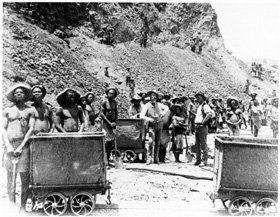 Cecil Rhodes and Barney Barnato, contend for commercial supremacy in the Kimberley diamond fields. To outproduce each other, they flood the market causing diamond prices to collapse.
Cecil Rhodes and Barney Barnato, contend for commercial supremacy in the Kimberley diamond fields. To outproduce each other, they flood the market causing diamond prices to collapse.
Up until the mid-1800s, diamonds were a rarity and could be seen only on the hand of a monarch. But the diamond rush that began in South Africa in the second half of the 19th century flooded the market with diamonds, which, as any good businessman knows, kills demand.
It would take some ingenious plotting and advertising to keep the diamond’s reputation as intrinsically valuable and desirable, which is where De Beers comes in. As a consequence, in 1888, De Beers Consolidated Mines Limited is established .
Consolidation
The tendency in diamond mining is to combine with smaller groups to form larger ones. Individuals needing common infrastructure form diggers committees, and small claim holders wanting more land merge into large claimholders. Thus, it only took a few years for De Beers to become the owner of virtually all South African diamond mines.
In 1890 ten English traders form the London Diamond Syndicate and commit to buy De Beers’ integral production. Diamond claim holders and distributors joined up with De Beers because their interests were the same: create a scarcity of diamonds and high prices will follow.
Alpha and Omega Diamonds history – the role of Ernest Oppenheimer
 In 1902 Ernest Oppenheimer turns up in Kimberley to toil as a diamond buying agent. 15 years later, in 1927, he establishes the Anglo American Corporation to advance gold mining in South Africa. Sir Ernest Oppenheimer, knighted for his wartime accomplishments, is elected to the De Beers Board in 1926. This happens after Anglo American, the enterprise he founded, becomes a considerable De Beers shareholder. In 1929 he will become chairman of the De Beers board. Under Oppenheimer, De Beers and its Central Selling Organization established exclusive contracts with suppliers and buyers, making it impossible to deal with diamonds outside of De Beers.
In 1902 Ernest Oppenheimer turns up in Kimberley to toil as a diamond buying agent. 15 years later, in 1927, he establishes the Anglo American Corporation to advance gold mining in South Africa. Sir Ernest Oppenheimer, knighted for his wartime accomplishments, is elected to the De Beers Board in 1926. This happens after Anglo American, the enterprise he founded, becomes a considerable De Beers shareholder. In 1929 he will become chairman of the De Beers board. Under Oppenheimer, De Beers and its Central Selling Organization established exclusive contracts with suppliers and buyers, making it impossible to deal with diamonds outside of De Beers.
The structure of the business remains the same for much of the 20th century: A De Beers subsidiary buys the diamonds. De Beers determines the amount of diamonds they want to sell, and at what price, for the whole year. Each producer then gets a cut of the total output, and buyers take their diamonds to be resold in places like Antwerp and New York.
A Diamond is Forever – Diamonds equate Love
In 1939, Harry Oppenheimer who joined the company’s board in 1934, moves for New York to initiate De Beers’ pioneering diamond advertising campaign. De Beers saw the United States as the next big market for diamonds, and they formed a very effective game plan to sell diamonds to Americans: convince them that diamonds equate love. Through advertising, they convinced men that the size of the diamond in an engagement ring showed how much they loved their fiancée. Movie stars were shown wearing diamonds in the relatively new motion pictures. And the most effective piece of advertising came in 1947, with the creation of the tag line ‘A diamond is forever.’ This later becomes the company’s official motto. As a result of these campaigns, the number of brides receiving engagement rings, and diamond prices in the U.S., increase dramatically.

Japan
Having conquered the United States by the 1960s, De Beers set its sights on new territories. Japan never had a tradition of romantic marriage, making diamonds a tough sell for brides. And even by 1959, no imported diamonds were allowed into the country by the postwar government. But by using slick advertising, playing up diamonds as a symbol of the modern West, or a way to break from traditional Japanese norm, De Beers was able to build a billion-dollar-a-year industry. By 1981, almost 60 percent of Japanese brides wore diamonds, up from 5 percent in 1967.
Maintaining control
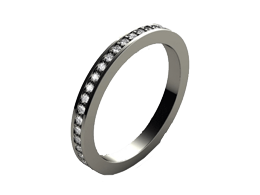 When faced with a threat to their diamond monopoly, like one from the Soviet Union, De Beers simply bought up their inventory to maintain complete control. The discovery of diamonds in Siberia in the 1950s was a threat to the control De Beers kept over the diamond supply. Rather than compete with Russian diamonds, De Beers offered to buy almost everything that came out of Siberia — funneling all the world’s diamonds through a “single channel.” Even though Russian diamonds were smaller, their use in “eternity rings” and other miniature jewelry proved very successful, and allowed for a lucrative partnership between De Beers and the USSR.
When faced with a threat to their diamond monopoly, like one from the Soviet Union, De Beers simply bought up their inventory to maintain complete control. The discovery of diamonds in Siberia in the 1950s was a threat to the control De Beers kept over the diamond supply. Rather than compete with Russian diamonds, De Beers offered to buy almost everything that came out of Siberia — funneling all the world’s diamonds through a “single channel.” Even though Russian diamonds were smaller, their use in “eternity rings” and other miniature jewelry proved very successful, and allowed for a lucrative partnership between De Beers and the USSR.
Expansion
De Beers begins an exploration program in Canada in 1960 and in 1964 De Beers Auction Sales, trading as Diamdel, begins backing non-sightholder ventures with rough diamond supplies. Between 1966 and 1969 diamond ore is discovered in Botswana and De Beers establishes Debswana, a partnership with the local government, to develop the Orapa Mine where production begins in 1971. Later, De Beers’ geologists unearth the Jwaneng kimberlite pipe, buried 150 metres below the surface. It becomes the world’s richest diamond mine, producing an average of 11 million carats per year.
Alpha and Omega diamonds history – De Beers in the 21st century
By the beginning of the 21st century, diamond-producing companies had enough of De Beers’ monopoly, forcing a change in structure for the company. Numerous “revolts” against the De Beers cartel had occurred in places like Zaire and Israel over the years. Theses were mostly quashed by De Beers releasing stockpiles of diamonds similar to that county’s product, driving down demand. But more recently, countries with enormous stockpiles of their own, like Russia, Canada and Australia, have refused to cooperate with the single channel system. These problems, along with issues of flat prices, forced De Beers to switch up the company’s strategy. In the first decade of the 21st century, De Beers moved away from rough-diamond supplying and controlling the entire industry, instead focusing on promoting its own brand of diamonds and retail stores.
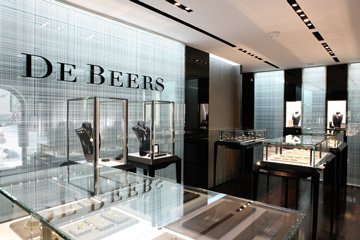
In 2001 the company sets up De Beers Diamond Jewellers (DBDJ) together with luxury brand LVMH Moët Hennessy Louis Vuitton. This business provides the world’s most knowledgeable customers with the world’s most dazzling diamonds.
Despite its high earnings and a lucrative transformation, De Beers ended its 80 year stranglehold on diamonds by selling a majority ownership to Anglo American plc. Anglo American, which previously had a 45 percent stake in the company, bought the De Beers Groups’ 40 percent share for $5.1 billion in cash. Anglo American, previously started by Oppenheimer, will take over De Beers from that very same family. As for the reason of the sale: apparently, there is no one in the Oppenheimer family that wants to continue in the diamond business.
We have no idea yet what the future will hold for De Beers, but we hope you have enjoyed the first part of the Alpha and Omega Diamonds history, of which more chapters will follow.

Sylvain Goldberg – on the Alpha and Omega diamonds history – De Beers
